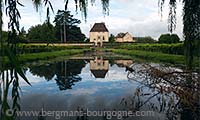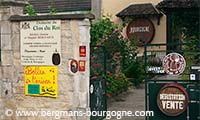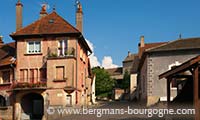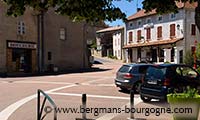
Of the Cotes-de-Nuits' 24 grand crus nine belong to Gevrey-Chambertin. There are 27 premier crus. The grand crus all lie south of the village, along the road to Morey-Saint-Denis, while the premier crus can be found both south and west of the village. The village AC vines can be found on all sides as well as right in the middle of the village. There are also 50 hectares in the neighbouring Brochon that are entitled to the Gevrey-Chambertin AC. All wine in Gevrey-Chambertin is red.
 Already on village level, appellation Gevrey-Chambertin, you quite often find various lieux-dits bottled separately. You will for instance find Clos-du-Couvent and Clos-du-Meix (both are monopoles) at Domaine de Varoilles, Clos Prieur at Domaine Marc Roy, Ételois at Domaine Rossignol-Trapet, Les Crais and La Justice at Domaine Gérard Seguin, Jouise and Clos Prieur at Domaine Harmand-Geoffrey and En Champs at Domaine Denis Mortet. Domaine Marchand-Grillot offers as much as five different bottlings of village Gevrey-Chambertin – En Songe, Au Vellé, Champerrier, Jouise and Le Crét.
Already on village level, appellation Gevrey-Chambertin, you quite often find various lieux-dits bottled separately. You will for instance find Clos-du-Couvent and Clos-du-Meix (both are monopoles) at Domaine de Varoilles, Clos Prieur at Domaine Marc Roy, Ételois at Domaine Rossignol-Trapet, Les Crais and La Justice at Domaine Gérard Seguin, Jouise and Clos Prieur at Domaine Harmand-Geoffrey and En Champs at Domaine Denis Mortet. Domaine Marchand-Grillot offers as much as five different bottlings of village Gevrey-Chambertin – En Songe, Au Vellé, Champerrier, Jouise and Le Crét.
– The Gevrey-Chambertin, Clos Prieur, is a parcel located near the grands crus that produces a very spicy wine, very complex and full-bodied and elegant at the same time. Even in its youth it is a very charming wine, says Alexandrine Roy at Domaine Marc Roy in Gevrey-Chambertin.
– Our Gevrey-Chambertin, Aux Etelois, is near the Route des Grands Crus, says Gilles Duroché at Domaine Duroché, also in Gevrey-Chambertin. Our vines begin by Griotte-Chambertin. We have 0.0192 hectares and it runs all the way down to the RN 74. It was replanted in 1977, 1957 and 1986.
 At Domaine Harmand-Geoffrey the Gevrey-Chambertin, Jouise, covers 1.10 hectares. The vines are between 60 and 80 years old.
At Domaine Harmand-Geoffrey the Gevrey-Chambertin, Jouise, covers 1.10 hectares. The vines are between 60 and 80 years old.
The Gevrey-Chambertin premier crus cover a total of 86 hectares and are usually divided into three groups. Up behind the village where the Combe Lavaux leads up into the Hautes-Côtes is where you'll find the most prestigious premier crus. From the inner part of the valley all the way to the Brochon border is the Côte Saint-Jacques, a slope that in the inner parts of the valley holds premier crus like Les Verroilles, Lavaut St Jacques, Le Clos Sait-Jacques and Les Cazetiers. Further out, where the slope faces more to the east Les Goulots, Combe au Moine, Petits Cazetiers and Champeaux.
– Champeaux is on a sort of a terrace, it's an old quarry. Very difficult to work, says Jérôme Galeyrand at Domaine Jérôme Galeyrand in Gevrey-Chambertin.
– If you compare the soil of Les Goulots with the soil of its neighbour, Combe au Moine, you will see that they are very different, says Stanislas Heresztyn at Domaine Heresztyn in Gevrey-Chambertin. In Les Goulots there is one part that is calcareous and one part that is calcareous with clay.
 When Jules Lavalle made his classification in 1855 he put some of the premier crus on the same level as today's grand crus. Chambertin and Clos de Bèze were the only ones to make it into the Tête de Cuvée category. One step down he grouped Chapelle, Mazy, Ruchottes, Charmes and Griotte (this was before the addition of Chambertin to the name of all grand crus) together with St Jacques, Le Clos Sait-Jacques, Verroilles, Estournelles and Cazetiers, as well as Fouchère, today part of Chambertin. At the same time he did not include the lower parts of the grand crus; these were placed yet another step down.
When Jules Lavalle made his classification in 1855 he put some of the premier crus on the same level as today's grand crus. Chambertin and Clos de Bèze were the only ones to make it into the Tête de Cuvée category. One step down he grouped Chapelle, Mazy, Ruchottes, Charmes and Griotte (this was before the addition of Chambertin to the name of all grand crus) together with St Jacques, Le Clos Sait-Jacques, Verroilles, Estournelles and Cazetiers, as well as Fouchère, today part of Chambertin. At the same time he did not include the lower parts of the grand crus; these were placed yet another step down.
The next group of premier crus is just behind the village, where the valley opens up into the plain. This is approximately northwest of the big strip of grand crus. These three premier crus – Clos du Chapitre, Craipillot and Champonnet – have a modest slope and calcareous brown soil.
Then finally you have the premier crus located on the same slope as the grand crus – Les Corbeaux, Au Closeau, La Perrière, Clos Prieur, Cherbaudes, Petite Chapelle/Champitenois, En Ergot, Fonteny, Plantigone/Issart, Bel Air and Aux Combottes. Most are below or north of the grand crus.
– Clos des Issarts is an amazing vineyard, says Erwan Faiveley at Domaine Faiveley, owners of this monopole since 2002. It is right next to Domaine Rousseau's Clos des Ruchottes and close to Mazis-Chambertin. It is a tiny premier cru surrounded by grand crus. It does of course produce a great wine, but another nice thing is that there is an old house in the middle of the clos. This house can, and will be at some point, be renovated and maybe I will move there. It will have to wait some time though. I have been talking to an architect and it will be quite an expensive project.
 – Les Corbeaux is next to Mazis-Chambertin, to the north, says Stanislas Heresztyn. Les Corbeaux and La Perriére (which is below Mazis-Chambertin, just on the other side of the road) are very different in character. In Les Corbeaux the grapes ripen a few days before La Perrière. Les Corbeaux lacks a bit of finesse, while La Perrière has more of it. Les Corbeaux has more clay and La Perrière more pebbles.
– Les Corbeaux is next to Mazis-Chambertin, to the north, says Stanislas Heresztyn. Les Corbeaux and La Perriére (which is below Mazis-Chambertin, just on the other side of the road) are very different in character. In Les Corbeaux the grapes ripen a few days before La Perrière. Les Corbeaux lacks a bit of finesse, while La Perrière has more of it. Les Corbeaux has more clay and La Perrière more pebbles.
Au Closeau is one of the smallest premier crus covering only 0.53 hectares. Domaine Drouhin-Laroze in Gevrey-Chambertin is the principal owner here, owning 80 per cent.
– We are the only ones to bottle it separately, explains Christine Drouhin at Domaine Drouhin-Laroze. I find this premier cru very elegant and fruity, similar to one of its neighbours, the premier cru Clos Prieur.
– For a long time my father vinified Craipillot and Au Closeau together, continues Philippe Drouhin at the same domaine. At that time the domaine only bottled three Gevrey-Chambertin premier crus - a blended premier cru, Lavaut-St-Jacques and Clos Prieur. In 2004 I decided to vinify the others separately as well. The Au Closeau is better than the Craipillot. Au Closeau is a good lieu-dit, it's just below Mazis-Chambertin. But you have to be careful with the yield here, or you'll end up with a very light wine.
The domaine's vines were planted in 1943. Au Closeau has La Perrière on two sides and Mazis-Chambertin just across the road.
 Bel Air is the only premier cru at the top of the slope, above Clos de Bèze at an altitude of more than 300 metres. At the southern end of the slope, on the border to Morey-Saint-Denis, is Aux Combottes. This premier cru has grand cru land on all sides – Latricières-Chambertin, Mazoyères-Chambertin and Clos de la Roche. The diminutive suffix "otte" refers to the small valley that opens up just above Aux Combottes. It forms a small hollow, slightly less well drained than its neighbours. Its location also affects the microclimate here; it is a bit more exposed to the northwinds.
Bel Air is the only premier cru at the top of the slope, above Clos de Bèze at an altitude of more than 300 metres. At the southern end of the slope, on the border to Morey-Saint-Denis, is Aux Combottes. This premier cru has grand cru land on all sides – Latricières-Chambertin, Mazoyères-Chambertin and Clos de la Roche. The diminutive suffix "otte" refers to the small valley that opens up just above Aux Combottes. It forms a small hollow, slightly less well drained than its neighbours. Its location also affects the microclimate here; it is a bit more exposed to the northwinds.
When Denis Morelot published his "La Vigne et le Vin en Côte d'Or" in 1831 he wrote: "Once you have passed Clos de la Roche you arrive in Gevrey and you see Chambertin, whose reputation in Europe has placed it among the world's finest wines. This climat runs almost all along the to the houses of Gevrey. It is narrow, towards the lower part of the slope it covers an area of about twenty-five hectares, which unlike Clos de Vougeot has no parts of lesser quality". After a brief mention of Clos de Bèze he added: "The other climats of Gevrey are Clos Saint-Jacques, Chapelle, les Mazis, Grillette and la Fouchère.
What Morelot did not mention was the fact that once you enter the commune of Gevrey-Chambertin from the Morey-Saint-Denis side you have Latricières-Chambertin upslope on your left, just after Aux Combottes, and Mazoyères-Chambertin downslope on your right.
 Latricières-Chambertin is roughly rectangular in shape covering 7.35 hectares, the southern extension of Chambertin itself. Since the mid-19th century 0.42 ha of Aux Combottes have been added to Latricières-Chambertin. In his book on Gevrey-Chambertin Jacky Rigaux he explains the etymology: "The Latin word tricae means something of little value, barren land. It's a fact that the soil is thin here and the subsoil hard. The vines undeniably have a tough life here. Previously this was known as La Tricière, before turning it into a single word.
Latricières-Chambertin is roughly rectangular in shape covering 7.35 hectares, the southern extension of Chambertin itself. Since the mid-19th century 0.42 ha of Aux Combottes have been added to Latricières-Chambertin. In his book on Gevrey-Chambertin Jacky Rigaux he explains the etymology: "The Latin word tricae means something of little value, barren land. It's a fact that the soil is thin here and the subsoil hard. The vines undeniably have a tough life here. Previously this was known as La Tricière, before turning it into a single word.
Right below Latricières-Chambertin is Mazoyères-Chambertin. Only the Route des Grands Crus separates them. The name is rarely seen on labels since most growers prefer to sell it as Charmes-Chambertin. For historical reasons Mazoyères-Chambertin may be sold as Charmes-Chambertin, but not the other way around. Mazoyères-Chambertin covers 18.59 hectares and Charmes-Chambertin 12.25 hectares. Lavalle placed the upper part of Charmes-Chambertin in the Première Cuvée category and the lower part together with the whole of Mazoyères-Chambertin in the Deuxième Cuvée.
 Here the calcarous soil is less thin, 30 cm to 35 cm. Mazoyères-Chambertin runs all the way down to the RN74 road, which is a rare thing. The only other grand cru to touch the main road is the Clos de Vougeot. Charmes-Chambertin, which is right below Chambertin, stops two thirds of the way, leaving room for the premier cru of Champs-Chenys. With pebbly soil, higher calcareous content than its neighbours and less fertile than Chambertin, Charmes-Chambertin produces wines that Jean-François Bazin describe like this in his book on Chambertin: "As you move up the slope in this climat, there is more and more elegance, with body taking precedence over fat".
Here the calcarous soil is less thin, 30 cm to 35 cm. Mazoyères-Chambertin runs all the way down to the RN74 road, which is a rare thing. The only other grand cru to touch the main road is the Clos de Vougeot. Charmes-Chambertin, which is right below Chambertin, stops two thirds of the way, leaving room for the premier cru of Champs-Chenys. With pebbly soil, higher calcareous content than its neighbours and less fertile than Chambertin, Charmes-Chambertin produces wines that Jean-François Bazin describe like this in his book on Chambertin: "As you move up the slope in this climat, there is more and more elegance, with body taking precedence over fat".
It is above the Route des Grands Crus that you will find the heart of the Gevrey-Chambertin grand crus – Chambertin and Clos de Bèze. It was at the creation of Clos de Bèze the name Gevrey appeared in print for the first time. This was around 640 and the duke of Burgundy, Amalgaire donated the Clos to the Abbye of Bèze. The donation included large areas of land, not just the Clos de Bèze. It included more land in Gevrey-Chambertin and stretched all the way up to marsannay and Couchey. Ownership remained unchanged for several centuries. Then in 1219 the Clos de Bèze changed hands into those of the Diocese of Langres.
 The Clos de Bèze stayed with the Diocese of Langres for another four centuries. Towards the end this period the vineyard was suffering badly from neglect; it had lost its surrounding walls and bushes had taken over much of the clos. The decline of the religious institutions during this period led to many vineyards being sold. In 1627 the Diocese of Langres decided to let Claude Jomard, prosecutor of the Parliament of Burgundy, rent it. Initially it was for a period of 20 years. When the lease came up for renewal it was decided to let Mr Jomard continue. In 1708 the Diocese decided it was time to en the lease and bring the Clos de Bèze back into their own care. This led to a very long process in court, lasting for several decades, but eventually the Diocese of Langres lost ownership of the clos.
The Clos de Bèze stayed with the Diocese of Langres for another four centuries. Towards the end this period the vineyard was suffering badly from neglect; it had lost its surrounding walls and bushes had taken over much of the clos. The decline of the religious institutions during this period led to many vineyards being sold. In 1627 the Diocese of Langres decided to let Claude Jomard, prosecutor of the Parliament of Burgundy, rent it. Initially it was for a period of 20 years. When the lease came up for renewal it was decided to let Mr Jomard continue. In 1708 the Diocese decided it was time to en the lease and bring the Clos de Bèze back into their own care. This led to a very long process in court, lasting for several decades, but eventually the Diocese of Langres lost ownership of the clos.
 A number of different owners followed and in 1750 Claude Jobart entered the scene. This was a man that later would become known as Monsieur de Chambertin. He started out with half of the Clos de Bèze and then, after having bought another large chunk in 1752 from the Fyot de La Marche family in Dijon, he became the principal owner of the clos. In addition to this he was also a major owner in Chambertin and in 1756 he acquired the right to add de Chambertin to his name.
A number of different owners followed and in 1750 Claude Jobart entered the scene. This was a man that later would become known as Monsieur de Chambertin. He started out with half of the Clos de Bèze and then, after having bought another large chunk in 1752 from the Fyot de La Marche family in Dijon, he became the principal owner of the clos. In addition to this he was also a major owner in Chambertin and in 1756 he acquired the right to add de Chambertin to his name.
Chambertin as a vineyard name does not go as far back as Clos de Bèze. First mentioned in print in the 13th century as Campus Bertini when a man named Bertin, a local farmer, decided to plant vines on the land he owned next to the Clos de Bèze. Hence the name Chambertin, champ Bertin – Bertin's field.
Later on in history Chambertin would surpass Clos de Bèze in international fame. There would be periods when the two grand crus would be lumped together, talked about simply as Chambertin.
Chambertin and Clos de Bèze are the centrepiece on the grand cru slope south of Gevrey-Chambertin. Side by side, mid-slope, they cover 12.90 hectares and 15.39 hectares respectively. The slope in Chambertin is slightly more gentle. Clos de Bèze is steeper, with thinner soil but also comes to an apex around the mid-point. That is to say that there is a rise from north to south and one from south to north, and they meet in a sort of hump. It also sits out from the slope slightly more, with an aspect more due east than east-southeast.
– Chambertin is very masculine, very powerful, says Philippe Drouhin at Domaine Drouhin-Laroze. Clos de Bèze is more elegant, elegant by nature, perhaps too elegant. It is very elegant, but if you are not careful there will not be enough structure. In a good Clos de Bèze you will have the structure of the Chambertin and the elegance of the Clos de Bèze. Chambertin is masculine, very masculine, similar to Latricières-Chambertin. And Chapelle-Chambertin is very elegant, like Clos de Béze.
© 2013 Ola Bergman













